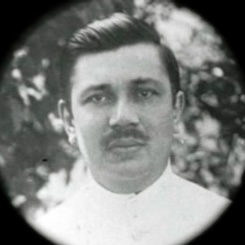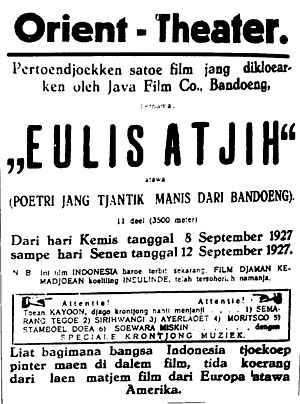G. Krugers facts for kids
Georg Eduard Albert Krugers (born November 4, 1890, died August 10, 1964) was an important cameraman and film director. He worked in the Dutch East Indies (which is now Indonesia) during the early 1900s. He started making films in the mid-1920s. His first film as a director was Eulis Atjih in 1927.
In 1928, he filmed a documentary about people going on the hajj pilgrimage. His 1930 film, Karnadi Anemer Bangkong, is believed to be the first "talkie" (a film with sound) made in the Indies. However, it was not very popular. After making two films for Tan's Film in the early 1930s, Krugers moved to Hong Kong and then to the Netherlands.
Early Films and Silent Movies
There are different ideas about Krugers' early life. Some records say he was born in Hong Kong. However, a newspaper report from 1933 said he was 43 years old and born in Banda Neira. A person named Georg Eduard Albert Krugers was indeed born there in 1890.
Krugers began working in film in the mid-1920s. He was in charge of the film laboratory at N.V. Java Film. He might have even helped start the company with L. Heuveldorp. This company mostly made documentaries. Then, in 1926, Heuveldorp directed Loetoeng Kasaroeng. This was the very first feature film made in the Dutch East Indies.
Krugers worked as a cameraman for Loetoeng Kasaroeng. This film was based on a folk story from the Sundanese people. He also processed the film in his laboratory in Bandung.
The next year, Krugers directed his own film, Eulis Atjih. This movie was about a beautiful woman named Eulis Atjih who becomes poor after her husband leaves her. When the film was shown internationally, people focused on its cultural aspects. The film did not make much money. But Krugers told his supporters that it had covered its costs. Later that year, Krugers left Java Film to start his own company, Krugers Filmbedrijf.
By 1928, he was reportedly working on films based on the folk tales Roro Mendut and Prono Tjitro. We don't know if he finished these films. However, he did complete a documentary called Het Groote Mekka-Feest. This film showed pilgrims from the Indies on their journey to Mecca. The film was first shown in Leiden, the Netherlands, on November 8, 1928. Many important Dutch people, including Princess Juliana, attended this premiere.
The Era of Talkies
The first "talkies" (films with sound) shown in the Indies came from the United States. These were Fox Movietone Follies of 1929 and The Rainbow Man, both from 1929. They were screened in late 1929. This inspired Krugers to make Karnadi Anemer Bangkong (Karnadi the Frog Contractor) in 1930. This comedy was made using a special camera Krugers got through his film industry connections.
Karnadi Anemer Bangkong is generally considered the first local talkie released in the country. However, its sound quality was not very good. It was also not popular with critics. Many in the Sundanese audience felt insulted by it. One director, Joshua Wong, suggested this was partly because the main character ate a frog. This is forbidden for Muslims.
After this film was not successful, Krugers made the documentary Atma De Vischer in 1931. This film followed Queen Wilhelmina and Prince Hendrik on a trip through The Hague. After this, Krugers started working for Tan's Film.
With Tan's Film, Krugers made two movies. First, he was the cameraman for Bachtiar Effendi's 1932 talkie Njai Dasima. This film was based on a novel from 1896. Then, Krugers directed and produced Huwen op Bevel (Forced to Marry; 1931). This film was advertised as having songs and comedy. However, it did not make much money. Because of this, Tan's Film bought all the rights to it. Krugers was planning two more films, De Nona and Raonah, but they were never made.
Between 1934 and early 1935, almost all feature films released in the Dutch East Indies were made by The Teng Chun. This happened because of the Great Depression. The government in the Dutch East Indies started collecting higher taxes. Advertisers asked for more money. And cinemas sold tickets at lower prices. This meant there was very little profit for local films. During this time, cinemas mostly showed films from Hollywood. Krugers left the Indies in 1936 and moved to Hong Kong. He later returned to the Netherlands, where he passed away in 1964.
Filmography
| Year | Film | Role(s) |
|---|---|---|
| 1926 | Loetoeng Kasaroeng (The Mystical Monkey) |
Cinematographer |
| 1927 | Eulis Atjih | Director |
| 1928 | Het groote Mekka-Feest (The Great Mecca Feast) |
Director |
| 1930 | Karnadi Anemer Bangkong (Karnadi the Frog Contractor) |
Director and producer |
| 1931 | Atma de Vischer | Producer, sound director, and cinematographer |
| 1931 | Huwen op Bevel (Forced to Marry) |
Director, producer, sound director, and cinematographer |
| 1932 | Njai Dasima | Sound director and cinematographer |



